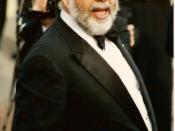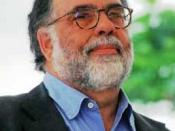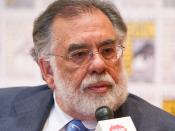In 1979, Vittorio Storaro was awarded the Oscar in Cinematography for Francis Ford Coppola's epic Vietnam War movie Apocalypse Now. In this film, Col. Walter E. Kurtz (Marlon Brando) is a high-ranking Green Beret who gets a few wires crossed in his head and declares himself a God among a group of Cambodian tribesmen. Captain Willard (Martin Sheen) is then sent on a mission to assassinate him "with extreme prejudice."
In the novel by Joseph Conrad, which this film is based on, we are introduced to what the author refers to as 'The Heart of Darkness'. The lighting in this film creates a realistic manifestation of the Heart of Darkness by using the extreme absence of light as its avatar.
The most poignant scenes where lighting is used to give the audience an impression of evil is also our first glance of the "Madman" himself. Throughout the course of this film, we come to know the background of Col.
Kurtz, and learn exactly what his views are on the Vietnam War. While he makes sense with his prophetic ramblings, it is questionable to determine if he is actually as insane as we are led to believe. With no key light used, and an orange fill light shining across his face and outlining his body, he leans in and out of the light during his dialogue with Capt. Willard.
Francis Ford Coppola was quoted as saying, "He used the light like a prop, we saw a little of him, then he pulled it in, so there's sort of a method to his madness." With the lack of light and his skin cast in complete shadows, we can easily determine that there is an internal conflict within Kurtz and that the Heart of Darkness has clearly affected him in some way.
Another scene where the lack of lighting is used effectively is during the Do Lung Bridge chapter of the film. During this scene, Capt Willard and his crew stop off for fuel to continue up the river. Upon their arrival, several soldiers along the pitch black river bank spring into the water begging to be taken away from the horrors of the battle as the PT boat docks at the encampment. With the use of spotlights swarming and acting as both key and fill lights, and flares and even Christmas lights used as both background lighting and props, a surreal battlefield is created in the midst of the darkness. With panicking soldiers firing into the unknown and the camp almost swallowed into darkness, a metaphor once again can be seen that areas plunged into complete shadows are also a bastion of evil.
The theory of the Heart of Darkness residing in the shadows is prevalent during the scene of Col. Kurtz' assassination. Again, through analysis of the film, it's apparent that Col. Kurtz is deep within the Heart of Darkness, and that in order to be removed from power one must descend into the depths of this evilness. Capt. Willard has become prepared for this and delves himself into the Heart of Darkness in order to carry out his mission. The lighting of the assassination scene reinforces this. Again, with a backlight directed towards the temple walls, and no fill or key light on Capt. Willard, all we see is his outline as he stalks down the hall toward his victim.
During the initial attack, both men are draped in darkness; however, with the backlight still on the temple walls and no key of fill lights used to show their features a silhouette effect is displayed, and we can see that Capt. Willard is ruthlessly slashing at Col. Kurtz. During his death, Col. Kurtz falls out of the darkness onto the floor. At this point, the lighting changes as the scene cuts; instead of a silhouetted figure, which would signify he was still affected by this Heart of Darkness, we see just the opposite. With no background light, and just a key and fill light shinning on Kurtz as he lay there, we can see that his face is no longer in the dark like it had been in all the other scenes, and the absence of light is now in the background. From this, we can ascertain that with Kurtz' death he has been set free from the Heart of Darkness, and that Capt. Willard, who is still in the darkness, has taken his place.
By effectively using extreme lighting differences, it was easy to see that the more the story moved along and unfolded the more evident the Heart of Darkness is. So, what exactly is the Heart of Darkness? During an interview with the Cinematographer Vittorio Storaro, he quoted, "The Heart of Darkness does not belong to the barbarian or to another culture, it is the traditional symbol of fear, hatred and evil."
Works Cited:
Apocalypse Now: Theatrical Release. Dir. Francis Ford Coppola,
Paramount Pictures, 1979. 153 min
Ebert, Roger. "Behind the Camera, Inside the Scene" InsideFilmIF May, 2002
URL: http://www.if.com.au/interviews/apocolypse-now-coppola.html
Kaufman, Anthony. "Shooting the 'Apocalypse'; IndieWIRE August 6th, 2001
URL: http://www.indiewire.com/people/int_Storaro_Vittor_01080.html


